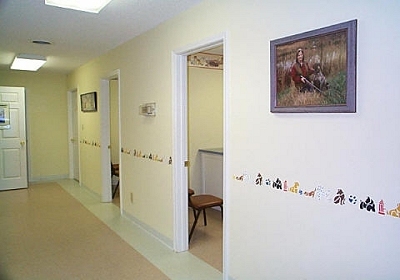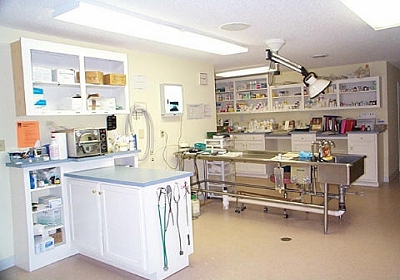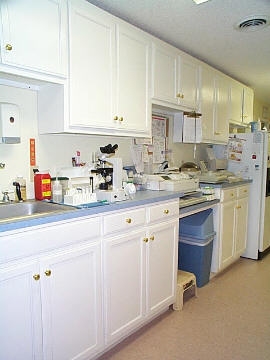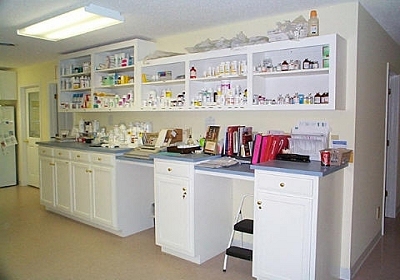
The Right Stuff -- What It Takes to Be A Veterinarian
The most frequent comments I hear from folks when they find out I’m a veterinarian are “My daughter wants to be a vet,” or “I wanted to be a vet.” The operative words are “want to” and “wanted to.” Then I hear this, “She really loves animals.”
Of course I love animals. It’s hard to find people who will admit they don’t love animals. But it takes much more than that to become a veterinarian.  Most veterinarians excel scholastically, often starting at a very young age. They should be naturals at science and math. By high school, future veterinarians should be in a college preparatory program with heavy emphasis on biology, chemistry, physics and math. They must be good at problem solving and analytical thinking.
They should choose a college or university with a good pre-veterinary program and at least a good track record of getting students into medical, dental or veterinary school. Most pre-vets major in the sciences-biology, zoology, biochem, microbiology, or animal sciences-poultry science, dairy science even meat production science.
In most cases, pre-vet students have enough of their pre-requisites to apply to veterinary school after the third year of college. Many will get into veterinary school after three years of college. But many have completed a four year college degree or higher before being admitted to veterinary school.
Veterinary schools are for four years. The first year is mostly basic sciences like anatomy, physiology, microbiology, parasitology. There is a little hands-on work with animals in the freshman year, but not much.
Most veterinarians excel scholastically, often starting at a very young age. They should be naturals at science and math. By high school, future veterinarians should be in a college preparatory program with heavy emphasis on biology, chemistry, physics and math. They must be good at problem solving and analytical thinking.
They should choose a college or university with a good pre-veterinary program and at least a good track record of getting students into medical, dental or veterinary school. Most pre-vets major in the sciences-biology, zoology, biochem, microbiology, or animal sciences-poultry science, dairy science even meat production science.
In most cases, pre-vet students have enough of their pre-requisites to apply to veterinary school after the third year of college. Many will get into veterinary school after three years of college. But many have completed a four year college degree or higher before being admitted to veterinary school.
Veterinary schools are for four years. The first year is mostly basic sciences like anatomy, physiology, microbiology, parasitology. There is a little hands-on work with animals in the freshman year, but not much.  The second year of veterinary school is more basic science transitioning to more clinically oriented classes in the third year. Students get more hands on experience with animals as they go.
All of the fourth year of veterinary school finds students in either clinical rotations in the teaching hospital or away doing preceptorships (sort of like a mini-internship). Now they are actually working with real patients with real owners.
Students take National and State Board exams before graduation. They also take a test to become Federally Accredited. This renders them capable of signing interstate and international health certificates and other government forms aimed at securing public health and food supplies.
After graduation, most states now require an internship. This is period of time when the new veterinary school graduate works under the supervision of a more experienced veterinarian.
The bottom line? Count on it taking seven to eight years of college and veterinary school to become a D.V.M. or V.M.D.
The second year of veterinary school is more basic science transitioning to more clinically oriented classes in the third year. Students get more hands on experience with animals as they go.
All of the fourth year of veterinary school finds students in either clinical rotations in the teaching hospital or away doing preceptorships (sort of like a mini-internship). Now they are actually working with real patients with real owners.
Students take National and State Board exams before graduation. They also take a test to become Federally Accredited. This renders them capable of signing interstate and international health certificates and other government forms aimed at securing public health and food supplies.
After graduation, most states now require an internship. This is period of time when the new veterinary school graduate works under the supervision of a more experienced veterinarian.
The bottom line? Count on it taking seven to eight years of college and veterinary school to become a D.V.M. or V.M.D.

The Organization of Veterinary Medicine - An Evolving Future
Most veterinary school grads become private practitioners in primary care practices. They are equivalent to human family practice specialists.  Part of the job is preventative medicine-stopping problems before they start with immunizations, worm preventatives, family planning surgeries, etc. Then there is the everyday task of seeing to the sick and injured.
But more and more primary care veterinarians rely on a backup system of specialists. Veterinarians who have had advanced training, done residencies and often research and taught in veterinary schools earn the right to take specialty board exams and become licensed as specialists.
Part of the job is preventative medicine-stopping problems before they start with immunizations, worm preventatives, family planning surgeries, etc. Then there is the everyday task of seeing to the sick and injured.
But more and more primary care veterinarians rely on a backup system of specialists. Veterinarians who have had advanced training, done residencies and often research and taught in veterinary schools earn the right to take specialty board exams and become licensed as specialists.
The more common specialties are:
- Surgery
- Internal Medicine
- Cardiology
- Oncology
- Dermatology
- Ophthalmology
- Radiology
- Neurology
- Pathology
- Emergency and Critical Care Medicine
There have always been concentrations of specialists in  colleges of veterinary medicine and their teaching hospitals. But there is now a trend towards large private practices with a number of specialists sharing a centralized, well-equipped hospital.
Many of these large hospitals are located in major metropolitan areas and serve as the specialty hospital by day and an emergency hospital at night and on holidays and weekends. colleges of veterinary medicine and their teaching hospitals. But there is now a trend towards large private practices with a number of specialists sharing a centralized, well-equipped hospital.
Many of these large hospitals are located in major metropolitan areas and serve as the specialty hospital by day and an emergency hospital at night and on holidays and weekends.
 Another trend in the veterinary industry is what’s known as telemedicine. Through the magic of computers, scanners and
other electronic devices, a primary care veterinarian may submit test results, x-rays, ultrasound images, and ECGs via a modem to a specialty practice where the test results can be interpreted by a specialist group. This allows patients in remote areas to receive a higher standard of care than had formerly been available to them. Another trend in the veterinary industry is what’s known as telemedicine. Through the magic of computers, scanners and
other electronic devices, a primary care veterinarian may submit test results, x-rays, ultrasound images, and ECGs via a modem to a specialty practice where the test results can be interpreted by a specialist group. This allows patients in remote areas to receive a higher standard of care than had formerly been available to them.

Your Primary Care Veterinarian Still Does a Lot!
Joke: Q: What’s the definition of a physician?
A: A veterinarian who’s only smart enough to work on one species.
Most veterinary clinics are self-contained mini-hospitals.  In addition to the rooms you see (the waiting room and examination rooms), most have a laboratory, radiology that includes an x-ray machine and a dark room to develop x-rays, a surgery with gas anesthesia, a treatment area and a fully stocked pharmacy.
In essence, the primary care veterinarian is a doctor, a surgeon, a dentist, an anesthesiologist, a radiologist and a pharmacist all rolled into one. In addition to the rooms you see (the waiting room and examination rooms), most have a laboratory, radiology that includes an x-ray machine and a dark room to develop x-rays, a surgery with gas anesthesia, a treatment area and a fully stocked pharmacy.
In essence, the primary care veterinarian is a doctor, a surgeon, a dentist, an anesthesiologist, a radiologist and a pharmacist all rolled into one.

The clinic or hospital has to be equipped to house sick and injured pets. Often they have wards that separate dogs from cats and contagious from non-contagious pets. And sometimes we have to go out of our way to keep the mean ones from eating the rest of them/us up!


|





 colleges of veterinary medicine and their teaching hospitals. But there is now a trend towards large private practices with a number of specialists sharing a centralized, well-equipped hospital.
colleges of veterinary medicine and their teaching hospitals. But there is now a trend towards large private practices with a number of specialists sharing a centralized, well-equipped hospital.


 In addition to the rooms you see (the waiting room and examination rooms), most have a laboratory, radiology that includes an x-ray machine and a dark room to develop x-rays, a surgery with gas anesthesia, a treatment area and a fully stocked pharmacy.
In addition to the rooms you see (the waiting room and examination rooms), most have a laboratory, radiology that includes an x-ray machine and a dark room to develop x-rays, a surgery with gas anesthesia, a treatment area and a fully stocked pharmacy.


